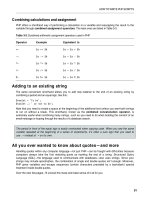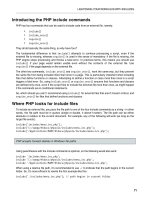Giải pháp thiết kế web động với PHP - p 1 potx
Bạn đang xem bản rút gọn của tài liệu. Xem và tải ngay bản đầy đủ của tài liệu tại đây (972.34 KB, 10 trang )
Download from Wow! eBook <www.wowebook.com>
PHP Solutions
Dynamic Web Design Made Easy
Second Edition
David Powers
ii
PHP Solutions: Dynamic Web Design
Made Easy, Second Edition
Copyright © 2010 by DAVID POWERS
All rights reserved. No part of this work may be reproduced or transmitted in any form or by any means,
electronic or mechanical, including photocopying, recording, or by any information storage or retrieval
system, without the prior written permission of the copyright owner and the publisher.
ISBN-13 (pbk): 978-1-4302-3249-0
ISBN-13 (electronic): 978-1-4302-3250-6
Printed and bound in the United States of America 9 8 7 6 5 4 3 2 1
Trademarked names may appear in this book. Rather than use a trademark symbol with every occurrence
of a trademarked name, we use the names only in an editorial fashion and to the benefit of the trademark
owner, with no intention of infringement of the trademark.
Distributed to the book trade worldwide by Springer-Verlag New York, Inc., 233 Spring Street,
6th Floor, New York, NY 10013. Phone 1-800-SPRINGER, fax 201-348-4505,
e-mail , or visit www.springeronline.com.
For information on translations, please e-mail , or visit www.apress.com.
Apress and friends of ED books may be purchased in bulk for academic, corporate, or promotional use.
eBook versions and licenses are also available for most titles. For more information, reference our Special
Bulk Sales–eBook Licensing web page at
The information in this book is distributed on an “as is” basis, without warranty. Although every precaution
has been taken in the preparation of this work, neither the author(s) nor Apress shall have any liability to
any person or entity with respect to any loss or damage caused or alleged to be caused directly or
indirectly by the information contained in this work.
The source code for this book is freely available to readers at www.friendsofed.com in the Downloads
section.
Credits
Lead Editor:
Ben Renow-Clarke
Technical Reviewers:
Kristian Besley and Jason Nadon
Editorial Board:
Steve Anglin, Mark Beckner, Ewan Buckingham, Tony
Campbell, Gary Cornell, Jonathan Gennick, Michelle
Lowman, Matthew Moodie, Jeffrey Pepper, Frank Pohlmann,
Ben Renow-Clarke, Dominic Shakeshaft, Matt Wade,
Tom Welsh
Project Manager:
Anita Castro
Copy Editor:
Heather Lang
Compositor:
Bronkella Publishing, LLC
Indexer:
Toma Mulligan
Artist:
April Milne
Cover Designer:
Anna Ishchenko
Cover Artist:
Corné van Doreen
CONTENTS
iii
Contents at a Glance
Contents at a Glance iii
Contents iv
About the Author xiii
About the Technical Reviewers xiv
Acknowledgments xv
Introduction xvi
Chapter 1: What Is PHP—And Why Should I Care? 1
Chapter 2: Getting Ready to Work with PHP 9
Chapter 3: How to Write PHP Scripts 29
Chapter 4: Lightening Your Workload with Includes 69
Chapter 5: Bringing Forms to Life 103
Chapter 6: Uploading Files 141
Chapter 7: Using PHP to Manage Files 179
Chapter 8: Generating Thumbnail Images 215
Chapter 9: Pages That Remember: Simple Login and Multipage Forms 243
Chapter 10: Getting Started with MySQL 279
Chapter 11: Connecting to MySQL with PHP and SQL 303
Chapter 12: Creating a Dynamic Online Gallery 335
Chapter 13: Managing Content 355
Chapter 14: Formatting Text and Dates 383
Chapter 15: Pulling Data from Multiple Tables 415
Chapter 16: Managing Multiple Database Tables 431
Chapter 17: Authenticating Users with a Database 459
Index 475
CONTENTS
iv
Contents
Contents at a Glance iii
Contents iv
About the Author xiii
About the Technical Reviewers xiv
Acknowledgments xv
Introduction xvi
Chapter 1: What Is PHP—And Why Should I Care? 1
How PHP has grown 2
How PHP makes pages dynamic 2
Creating pages that think for themselves 4
How hard is PHP to use and learn? 5
Can I just copy and paste the code? 6
How safe is PHP? 6
What software do I ne ed to write PHP? 6
What to look for when choosing a PHP editor 7
So, lets g et on with it . . 8
Chapter 2: Getting Ready to Work with PHP 9
Checking whether your website supports PHP 9
Deciding where to test your pages 10
What you need for a local test environment 10
Individual programs or an all-in-one package? 11
Se tting up on Windows 11
Getting Windows to display filename extensions 11
Choosing a web server 12
Installing XAMPP on Windows 12
Installing PHP with the Microsoft Web Platform Installer 16
CONTENTS
v
Se tting up on Mac OS X 19
Installing MAMP 19
Testing and configuring MAMP 20
Checking your PHP se ttings (Windows and Mac) 21
Editing php.ini 25
Where to locate your PHP files 26
Whats nex t? 27
Chapter 3: How to Write PHP Scripts 29
PHP: The big picture 30
Telling the server to process PHP 30
Embedding PHP in a web page 31
Storing PHP in an external file 31
Using variables to represent changing values 32
Ending commands with a semicolon 34
Commenting scripts 34
Using arrays to store multiple values 35
PHPs built-in superglobal arrays 36
Understanding when to use quotes 37
Making decisions 39
Making comparisons 41
Using indenting and whitespace for clarity 42
Using loops for repetitive tasks 42
Using functions for preset tasks 42
Understanding PHP classes and objects 43
Displaying PHP output 44
Understanding PHP error messages 45
PHP: A quick reference 47
Using PHP in an existing website 48
Data types in PHP 48
Doing calculations with PHP 49
Adding to an existing string 51
All you ever wanted to know about quotes—and more 51
CONTENTS
vi
Creating arrays 55
The truth according to PHP 57
Creating loops 62
Modularizing code with functions 64
PHP quick checklist 67
Chapter 4: Lightening Your Workload with Includes 69
Including code from ex ternal files 70
Introducing the PHP include commands 71
Where PHP looks for include files 71
Choosing the right filename extension for includes 74
Creating pages with changing content 83
Preventing errors with include files 92
Choosing where to locate your include files 98
Adjusting your include_path 98
Why cant I use site-root-relative links with PHP includes? 100
Security considerations with includes 101
Chapter review 101
Chapter 5: Bringing Forms to Life 103
How PHP gathers information from a form 103
Understanding the difference between post and get 105
Keeping safe with PHP superglobals 107
Removing unwanted backslashes from form input 108
Processing and validating user input 110
Creating a reusable script 110
Preserving user input when a form is incomplete 115
Filtering out potential attacks 118
Sending email 121
Using additional email headers safely 122
Keeping spam at bay 129
Handling multiple-choice form elements 132
Chapter review 140
CONTENTS
vii
Chapter 6: Uploading Files 141
How PHP handles file uploads 142
Checking whether your server supports uploads 142
Adding a file upload field to a form 143
Understanding the $_FILES array 144
Establishing an upload directory 146
Uploading files 147
Moving the temporary file to the upload folder 148
Creating a PHP file upload class 150
Defining a PHP class 151
Checking upload errors 156
Changing protected properties 161
Explicitly changing a data type 166
Preventing files from being overwritten 166
Uploading multiple files 171
How the $_FILES array handles multiple files 171
Using namespaces in PHP 5.3 and later 176
Using the upload class 177
Points to watch with file uploads 178
Chapter review 178
Chapter 7: Using PHP to Manage Files 179
Checking that PHP has permission to open a file 179
Configuration settings that affect file access 180
Creating a file storage folder for local testing 181
Reading and writing files 181
Reading files in a single operation 181
Opening and closing files for read/write operations 188
Exploring the file system 195
Inspecting a folder with scandir() 195
Inspecting the contents of a folder with DirectoryIterator 196
Restricting file types with the RegexIterator 198
CONTENTS
viii
Accessing remote files 203
Consuming news and other RSS feeds 204
Using SimpleXML 205
Creating a download link 210
Chapter review 213
Chapter 8: Generating Thumbnail Images 215
Checking your servers capabilities 216
Manipulating images dynamically 216
Making a smaller copy of an image 217
Resizing an image automatically on upload 235
Extending a class 235
Using the Ps2_ThumbnailUpload class 240
Chapter summary 241
Chapter 9: Pages That Remember: Simple Login and Multipage Forms 243
What s essions are and how they work 243
Creating PHP sessions 245
Creating and destroying session variables 246
Destroying a session 246
Regenerating the session ID 247
The “Headers already sent” error 247
Using sessions to restrict access 247
Using file-based authentication 251
Making passwords more secure 258
Se tting a time limit on sessions 270
Passing information through multipage forms 273
Chapter review 278
Chapter 10: Getting Started with MySQL 279
Why MySQL? 280
Which version? 280
How a database stores information 281
How primary keys work 281
Linking tables with primary and foreign keys 282









